
“This week was very uneventful, which can be a good thing. Aches and pains continued, but nothing major. And that’s about all there is to report. Short and sweet.
“Thank you,
“Hari Hari,
“Baladeva”
He does his daily sadhana and laments he
doesn’t go higher. What do you expect,
little sailor—to achieve the saksad
darsana of the Lord? To converse with
Him like Sanatana Gosvami and
Madana-mohan?
To immerse yourself in His wonderful
qualities and His pastimes with the
gopis? Well, why not? That’s the goal
of the chanting.
Ah, but He has to allow you in
those sacred precincts, and He
doesn’t think you’re worthy just
yet. Chant with enthusiasm,
confidence, and patience at the
lower stage and pray that the day
will come.
*****
In the present millennium, which lasts 430,000 years, only one method of achieving God consciousness is possible. That is the chanting of the holy names of God, specifically, the maha-mantra: Hare Krsna, Hare Krsna, Krsna Krsna, Hare Hare / Hare Rama, Hare Rama, Rama Rama, Hare Hare. It is very easy to perform. It can be done by singing (even without musical instruments) or by chanting silently on beads, at least sixteen rounds a day while avoiding offenses such as inattention to chanting and blaspheming devotees. By chanting Hare Krsna, the reactions to all of your previous sinful activities are vanquished, and you can become liberated from birth and death. (Srimad-Bhagavatam 3.23.8, purport)
Who is such a fool that he will not take up this process of chanting Hare Krsna? The devotees of the Lord take up the mission of inducing people to chant. This makes them very dear to Krsna. But before inducing others to chant, one must chant himself under the instructions of the spiritual master. Srila Prabhupada has said that of all the instructions of the spiritual master, the instruction to chant sixteen rounds a day is essential. How about you, dear reader? Do you chant sixteen rounds? As a servant of my spiritual master and as your humble well-wisher, I beg you to do so.
*****
Sign on a bumper sticker: “Life Is Good.” Put the Hare Krsna mantra on your bumper sticker. Most people won’t relate to it, but it’s good for them to see. Allen Ginsberg wrote the Hare Krsna mantra in one of his poems in a somewhat disparaging way. The poem was about all the mail he gets. Some Hare Krsna devotees knew he was favorable to Hare Krsna, so he sarcastically wrote that many of them send him letters that say, “Dear Allen: Hare Krsna, Hare Krsna, Krsna Krsna, Hare Hare / Hare Rama, Hare Rama, Rama Rama, Hare Hare.” Despite his sarcastic intention, it was good that he wrote the mantra in his poems. Even if the mantra is spoken sarcastically, it is beneficial.
*****
You chant your japa quickly and then slowly. Sometimes you get sleepy. You have heard that even negligent japa brings great benefit, so powerful is hari-nama. The names are more merciful than Krsna the person. They are Krsna in the form of sacred syllables. You try to vibrate them out loud, loudly, but you’re not always successful. But you always push them out. When you are not writing, you are chanting. You ask your body to cooperate, but it is slowing down and ailing. Even Haridasa Thakura began to chant fewer rounds in his old age, but Lord Caitanya told him not to worry, he was already liberated. At In his prime, Haridasa chanted three hundred thousand names a day. They gave it all they had, and the Lord empowered them. Their chanting was suddha-sattva, completely transcendental, with no offenses. They saw Krsna in His names. They loved to chant and never diverted their attention. Saint Thérèse of Lisieux compared herself to a little sparrow who looked up to the great eagles, the saints like Teresa of Avila. I want to be like that, a little worshiping sparrow looking up admiringly at the great ones.
*****
Japa must be an intense endeavor. It is not a laid-back thing. As you chant, you simultaneously brush out of the thoughts, like using a hand brush and a dustpan. You keep your mind clean. As for thinking of the pastimes of Radha and Krsna, I have not reached that stage. I am a mantra-chanter. I am trying to avoid the ten offenses in chanting. On one level, I’m doing it pretty well, but not going further. I don’t blaspheme devotees. I don’t consider the names of the demigods as equal or independent of the name of Krsna. I don’t doubt the scriptures;, I don’t take the chanting as exaggeration or make an interpretation of it. I chant with attention. I don’t commit sinful activities on the strength of chanting. I don’t consider the chanting a material act of piety. I don’t teach the chanting of the holy names to faithless persons. I don’t chant for material benefits. I try to avoid these basic offenses. But I don’t cry out to Krsna and Radha, “Please let me serve You.” I don’t dwell on Their sweet pastimes . . . .
*****
You’re not really chanting as well
as you claim you are. There are
mountains and mountains ahead of
higher achievement. You are only
in the foothills of hari-nama.
But you’re grateful to be living in
Hare Krsna space, breathing the
rare air of transcendental sound
vibration. Your spiritual master has
given you a great gift, you owe it
to him to lift yourself higher to
chant without offense. Go into
your heart and cry out for the
mercy, don’t be content with the
quota.
*****
I like chanting the maha-mantra. I’m familiar enough with the words “Hare,” “Krsna,” and “Rama.” They please me as they pass through my mind and lips. I’ve been doing it so long it’s become a love and a deep attachment. I could never switch to another kind of prayer of another religion, or even another mantra in the Vedic religion. This is it for me. I began in 1966, and I’ll continue it until the end. Prabhupada was so expert as to cement it to my being, and the mantra itself has the potency that once you chant it, you never want to stop. I’m like Gopa-kumara, who, no matter where he went, chanted his Gopala mantra, because it brought him more satisfaction than anything else, even when he was in the heavenly planets or Vaikuntha. He was always restless unless he was chanting his diksa mantra. The Hare Krsna mantra stays with you so that you chant it even in the dentist’s office or in the car after you’ve chanted your minimum prescribed rounds.
*****
You can’t speculate. You can do it for many years, but you’ll never understand. Guru means weighty. People think, “I know everything.” In the Vedic system, a child goes to gurukula and works as a menial servant of the guru. The guru can ask him to do any kind of duty, and he does it. Even Krsna went to gurukula. Caitanya Mahaprabhu accepted a guru. Prakasananda Sarasvati was criticizing Lord Caitanya as a sentimentalist for chanting. Prakasananda asked him, “Why don’t You study Vedanta?” Caitanya Mahaprabhu replied, “My guru found Me to be fool number one. He said, ‘You can’t read Vedanta-sutra.” Caitanya Mahaprabhu took the part of an ordinary person. Therefore, Caitanya Mahaprabhu said, “He advised Me to chant Hare Krsna, and I’m getting the result.” In the present age, people aren’t interested in Vedanta. They are very bad and slow. But it is meant for everyone.
*****
Say it over and
over again, the
maha-mantra.
Say it over and over
again, thousands of
times, from your
heart.
Let Krsna’s names vibrate
in your room as you finger
your beads. Let the early
hours go by and repeat the
mantras without cessation.
That’s the way to Krsna in this
age. It’s the best way to realize
that the name is Him. By many
repetitions without offenses, you
will realize
success in spiritual life.
Say it over and over
again: Hare Krsna Hare
Krsna Krsna Krsna Hare
Hare Hare Rama Hare
Rama Rama Rama
Hare Hare. Say it until you’re
tired, and then say more.
*****
Good mechanical chanting is not suddha -nama, but it’s important. It means you’re attentive, concentrated and conscientious. Today I’ve been chanting with good mechanics, and I’m gratified. Since I started a little late, I’ve only chanted eleven rounds, but I’m sure I’ll make them up later—with good mechanics.
Chanting “mechanically” sounds derogatory.
But if you chant well tuned, you’re on the
good side. You handle each mantra with
care, like a part of an assembly line.
You’ve got a long way to go to chanting
with bhava, but you’ve made a good start.
Chanting as duty, the mind on the count,
struggling to keep alert. This chanting is
not what Prabhupada said would equal
Dhruva’s austerity. You completed your
assignment, but not with the presence of
mind that, “Here is Krsna, here is Radha,
please engage me in Your service.”
*****
On winning the NBA championship, basketball star Kobe Bryant said, “I feel as if a huge monkey has been lifted off my back.” When I finish my daily quota of japa, I feel as if a monkey has been lifted off my back. Of course, it is a guaranteed thing that I will finish my vow every day. But until it is completed, I am not relieved. Prabhupada has given us the sixteen-round quota, and it must be done. It is a pleasure to be able to complete the quota and keep that bond with him every day. It makes you feel successful in your personal commitment to him. Sometimes some of the later rounds are not done as well as the beginning rounds. There is a touch of getting them out of the way. But sometimes that doesn’t happen, and you go strong through the whole quota. That is best. The concept of completing a solemn vow every day is very good for one’s sadhana. And chanting some extra makes you feel good. You feel clean and honest, and you wouldn’t have it any other way. It must be done, even if you have a headache and some of the last rounds are of poor quality.
*****
Chanting is a great endeavor. I want to give my full attention to each mantra and feel the pastimes of Krsna in my mind. But I can’t do it. I lower my standards and chant. I hear the syllables and keep a good pace. So many people chant without a higher taste, assured that they are doing the best thing. I am one of them. Chanting is like being with your best friend. I relax and utter Their names. Even if it is not topmost, I chant with reverence and attention as best as I am able. I ask Krsna’s forgiveness that I’m not doing better. I’m aware of all my physical and mental limitations that prevent me from soaring into the spiritual realm. At least I prevent my mind from ranging into other subjects. I keep it focused on the mantras themselves. Time goes by, and I’m very careful to use every moment for chanting and not something else. But the time slips by without top performance.
pp. 41-43
I remember an autobiography that Eleanor Roosevelt wrote after her husband passed away. The title expressed her feeling: “My life is empty now, and I am just passing a few more years—the real person in my life is gone.” But we are not resigned like that. We have to increase the intensity of our attachment to our spiritual master.
In Caitanya-caritamrta, Adi-lila Chapter One, there are very authoritative, definitive descriptions of the spiritual master. In one purport, Prabhupada writes,
“The service to the spiritual master is essential. If there is no chance to serve the spiritual master directly, a devotee should serve him by remembering his instructions. There is no difference between the spiritual master’s instructions and the spiritual master himself. In his absence, therefore, his words of direction should be the pride of the disciple. If one thinks that he is above consulting anyone else, including his spiritual master, he is at once an offender at the lotus feet of the Lord.”
In the concluding words to the Caitanya-caritamrta, Prabhupada speaks about his relationship with his spiritual master, Srila Bhaktisiddhanta Sarasvati Thakura, in separation. These references help us in understanding our connection with our spiritual master, who has now left this material world. We know that Krsna also left the material world five thousand years ago, although He’s actually in the heart of every living being. And similarly the spiritual master is in the heart of the devotee —just as much as the Lord is there—though not in exactly the same way. Of course, we don’t fully understand how the Lord is there, but at least we’ve heard enough from the scriptures that we can begin to understand and accept it. And the same thing applies to our relationship with our spiritual master. If we serve with love, then Krsna and the spiritual master will give us the intelligence to understand these things.
In his concluding words of Caitanya-caritamrta, Srila Prabhupada writes,
“I still consider His Divine Grace to be always present with me by his vani, his words. There are two ways of association—by vani and by vapuh. Vani means words, and vapuh means physical presence. Physical presence is sometimes appreciable and sometimes not, but vani continues to exist eternally. Therefore we must take advantage of the vani, not the physical presence. Bhagavad-gita, for example, is the vani of Lord Krsna. Although Krsna was personally present five thousand years ago and is no longer physically present from the materialistic point of view, Bhagavad-gita continues.”
Then Prabhupada tells the whole wonderful story of how he met his spiritual master and how he gradually formed his life in service to his spiritual master. He started Back to Godhead magazine, began writing Srimad-Bhagavatam, and finally came to America.
At the end of this passage, Srila Prabhupada writes, “I think that His Divine Grace Bhaktisiddhanta Sarasvati Thakura is always seeing my activities and guiding me within my heart by his words.” This is not merely a poetic metaphor. The Supersoul is not alone, but is present with all His associates. Certainly the spiritual master is an associate of the Lord, especially in the heart of his disciples. So the Lord is there, and He is there with His devotees and associates.
“It is to be admitted that whatever translation work I have done is through the inspiration of my spiritual master, because personally I am most insignificant and incompetent to do this materially impossible work. I do not think myself a very learned scholar, but I have full faith in the service of my spiritual master, His Divine Grace Srila Bhaktisiddhanta Sarasvati Thakura. If there is any credit to my activities of translating, it is due to His Divine Grace. Certainly if His Divine Grace were physically present at this time, it would have been a great occasion for jubilation, but even though he is not physically present, I am confident that he is pleased by this work of translation.”
So Prabhupada is telling us that his guru is with him, and that his guru is pleased.
pp. 238-39
Well, dear folks, here is the straight skinny, as we used to say in the Navy (meaning it’s the straight information). I am at a crossroads, thinking that maybe I’ll do only one of these chapters per day and use my time for something else. This is my row to hoe.
The idea of this book is to keep going, and that’s what I’m writing now. You either go ahead or you don’t. You trust or you don’t.
I want to trust, but I am egging myself to trust the deeper and not assume that just easygoing typing is writing (as Truman Capote said). I don’t believe in that polished prose and sentence structure and paragraphs of argument. I can’t do stories where I think out in thousands of words beforehand some imaginary character who won’t make it anyway. Then, then?
If I were in the Samadhi Mandir or Prabhupada’s rooms in Vrndavana, I could write, “O Prabhupada, I have come before you. Sitting here I see the Indian women with bundles on their heads . . . ” But I am in Wicklow, Ireland. I watched the recent T.V. shows where the devotees made good appearances. Time is running out. Fifteen more days. I’d like to start something bright . . . but wouldn’t it be much of the same? You can’t escape your destiny . . .
No one can surpass the time representation of the Supreme Personality of Godhead by material power, by the counsel of ministers, by intelligence, by diplomacy, by fortresses, by mystic mantras, by drugs, by herbs or any other means.
Unless providence is in our favor, we shall not be able to gain victory. Therefore we must wait for that favorable time when our defeating them will be possible.
—Bhag. 8.21.22, 24
It has to be your time, then you can win. You have to wait to see what Krsna wants, what He wants you to do. Go into a trance and trust the unconscious. You mean a hunch? At least I may have to wait for some time. You could draw a picture and maybe the idea will come to you that way.
Everyone feels lonely from time to time. The drunkard hits the bottle. You may go into the streets. Take a walk. But don’t avoid it …
It may take some time, but keep looking and waiting. But you can’t wait forever. I especially have a limited time on these retreats and have to go forward with what is coming. It’s really easy. I can always follow my nose.
It’s just a matter of being attached to a group of chapters already started or something like that.
Yeah, but you’ve got to keep promises too. You can’t, for example, leave your wife if you decide you don’t love her anymore. You have to work at the thing.
Yes, that’s true.
Evers to Tinker to Chance,
the ball is thrown. I want dynamite not.
I want to be a peaceful reader. Hereby declare,
“I shall read five or eight hours a day
in my spiritual master’s books and to hell
with my writing and morning walks.”
No, it’s your preaching. You need it.
Then what is the difference between
what you want to do and what you should do and
what is best for you and what Prabhupada
wants you to do and what
the Centennial committee
will say you ought to do if you fax them,
“Please direct me how I can please
Prabhupada best in 1996”?
Tinker to Evers to Chance.
You have to smoke out the raccoon in you.
Wait for the ballroom dance to end—
or rather leave it,
run away from bad association.
But be calm, be calm, and you know
Krsna will give you a good idea.
pp. 47-49
There are two Varaha murtis in Mathura. One is worshiped in a house, and “non-Hindus” are not allowed to enter. That’s okay because you can see Him through the window during darsana times. The other Varaha murti is much older. This murti was worshiped by Ravana and then recovered by Lord Rama over five thousand years ago.
We read about the boar incarnation in our first years in ISKCON. Prabhupada told us that God descends as a hog and we believed him. He described Him as a beautiful boar with a gorgeous voice. He lifted the earth planet on His tusks and killed Hiranyaksa.
I do believe that Varaha is real. I know it sounds strange to my Western self, but I am working to cast that off. If the Muslims could build a mosque with the broken pieces of a mandira, why can’t I build faith with the broken pieces of my skepticism? With broken bones, broken promises, broken dreams, I build a world of faith. “It’s not religious faith,” Srila Prabhupada said. “That kind of faith can change.” True religion means to serve God and obey His laws, and that is eternal.
Where do I fit in, in this world of epics and itihasas and Vedas and Upanisads? My spiritual master will be satisfied to see me taking the maha-prasadam he is offering. I have no teeth, but I am greedy.
The Varaha murtis don’t move me to ecstasy because I am a dry worm. I admit it. But I also admit that He does look beautiful in His red cloth and His gleaming tusks. I pray to Him to kill the demons and to save me.
I remember reading those chapters in the Third Canto when they were first composed. I was typing them from Swamiji’s dictation. Those were the good old days when I read and edited his manuscripts in the evening at the Boston University Library. Then I would catch a trolley home, where a cold meal awaited me with bread balls so hard you had to smash them with a hammer. Jadurani painted a primitive-looking Varaha, and we hung it on the wall. Dear Lord Varaha, I am not a Hindu nor a non-Hindu. I am a prabhupadanuga. I worship You. Lord Caitanya assumed Your form and climbed on the back of Murari Gupta.
I have commented on three of the Mathura tirthas, but I haven’t included the post office or the rickshaw drivers or the grubby shops, the Holi Gate. . . . O Mathura, Krsna killed Kamsa here. Everything still awaits the eager pilgrim, but we have to find it amid the modern trappings.
There is a large Deity of Visnu here to show the form Krsna assumed to allay the fears of His devotees who thought Kamsa could kill their darling boy. So don’t fear. Krsna has come to Mathura as a hero. He will kill all the demons—the elephant, the wrestlers, the soldiers, the washerman. He will break the bow and finally the king. To convince His mother that Kamsa is actually dead, He will drag Kamsa’s corpse around the wrestling arena as a lion drags his kill.
In Mathura, Krsna straightened Kubja’s back. She wanted to enjoy Krsna for herself, and therefore her service wasn’t as exalted as that of Krsna’s queens. The gopis are the purest of all. Kubja is in her own category. Her saving grace is that she didn’t want to enjoy with Kamsa, but with Krsna. He satisfied her. As soon as she touched His lotus feet, her material lust subsided. You won’t find a trace of that pastime in Mathura now, except in the minds and words of the Vaisnavas.
About Raman-reti, Lord Krishna speaks to His cowherd friends:
“My dear friends, just see how this riverbank is extremely beautiful because of its pleasing atmosphere, and just see how the blooming lotuses are attracting bees and birds by their aroma. The humming and chirping of the bees and birds are echoing throughout the beautiful trees in the forest. Also, here the sands are clean and soft. Therefore, this must be considered the best place for our sporting pastimes.”
—Bhagavat Purana
Autumn:
even without tail feathers
the peacock struts.
Land of Vraja,
with his rear legs
the dog kicks up dust.
Cool weather:
new piglets
crowd the lane.
I meditate
under a jhokra tree
where thrushes are quarreling.
The temple of Madan-mohan (Krishna, the attractor of Cupid) was built five hundred years ago by Sanatan Goswami. We go for a predawn visit. Red limestone dome ruining with age, fresh grass atop.
At the ancient well
A painting in his kutir:*
once used by Sanatan,
Sanatan in loincloth
visited by Krishna.
a bare sadhu bathes.
It was quiet
’til you awoke—
sparrow.
Singing softly a sadhu
bows before another
sadhu’s tomb.
Jiva Goswami established the Radha-Damodara temple in 1599 and installed the Deity of Krishna known as Damodar, “One whose mother tied Him with ropes.” Here great saints would gather to glorify Krishna.
At Jiva’s tomb,
my knees touch stone—
the monkeys move in closer.
With drums and cymbals,
the poor people
enter the temple singing.
Walking quickly,
chanting Hare Krishna:
a supple, barefoot boy.
Srila Prabhupada, my spiritual master, lived at Radha-Damodar temple in the early 1960s. He would rise in the early morning hours and translate the Bhagavat Purana and think of giving Krishna to the world.
Sitting reverently
in my master’s room,
I stretch out my legs.
Thinking what was it like
when he was here.
A frog jumps through the lattice.
The window view—
devotees walk
past Rupa’s kutir.
Locking the room,
taking the dust
of the Vaishnavas.
“When shall I become fortunate to visit Mathura-puri and shed tears of bliss as I drink from the stream of nectar flowing from the mouths of the old guides there who say, ‘Here was Nanda Maharaja’s home. Here the cart was broken. Here Lord Damodar, who breaks the bonds of birth and death for His devotees, was Himself tied with ropes by mother Yashoda. Here by the Yamuna River Krishna killed the Keshi demon’ ? “—Sri Kavisekhara
Talking loudly
an oarsman
plies through the Yamuna.
“In my books the philosophy of Krsna consciousness is explained fully, so if there’s anything, you do not understand, then you simply have to read again and again. By reading daily, the knowledge will be revealed to you, and by this process your spiritual life will develop… You may please me the most by reading my books and following the instructions therein.“ (Letter to Bahurupa, November 22, 1974)
A devotee in Mayapura once got up to leave in the middleof one of Prabhupada’s lectures. “Where is he going?“ Prabhupada asked. “He has some work to do,“ a devotee answered. This drew fire from Prabhupada. “What work? Nonsense! Unless you hear, what work can you do? It will just be karma unless you hear.“ We cannot just read the books and do nothing for the spiritual master, but neither can we serve without the knowledge gained by reading the books. As Prabhupada states in the letter quoted above, we must both read the books and follow the instructions. This is the combination that pleases the spiritual master the most.
Although Prabhupada provided answers to every question, sometimes devotees cannot understand the spiritual technologies described in them. In this letter, Prabhupada indicates that simply by reading his books again and again, we will, in time, come to understand. Reading Prabhupada’s books is not just an academic exercise or way to accumulate knowledge. Rather, it allows us to break through our material conditioning and receive the highest spiritual realization. As Prabhupada states, our spiritual lives develop by reading the books every day.
In the Siksastakam Lord Caitanya compares the cleansing of the mind to the cleansing of a mirror, and in his letter, Prabhupada makes a similar comparison: “Presently our consciousness is just like a mirror becomes covered with dust. So the cleansing process is this chanting, and hearing, and doing some service, and trying to please the spiritual master.“ On a mirror dust accumulates daily, and to keep the mirror clean that dust must be daily removed. The same is true of the mind and its contaminants. By hearing, chanting, and serving, the mind becomes clear, but unless we practice these activities every day, we will again become covered.
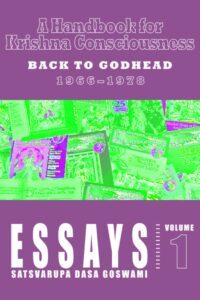
This collection of Satsvarūpa dāsa Goswami’s writings is comprised of essays that were originally published in Back to Godhead magazine between 1966 and 1978, and compiled in 1979 by Gita Nagari Press as the volume A Handbook for Kṛṣṇa Consciousness.
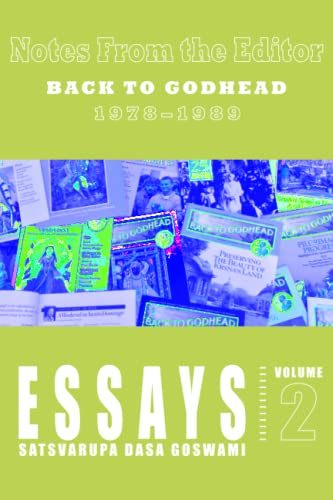
This second volume of Satsvarūpa dāsa Goswami’s Back to Godhead essays encompasses the last 11 years of his 20-year tenure as Editor-in-Chief of Back to Godhead magazine. The essays in this book consist mostly of SDG’s ‘Notes from the Editor’ column, which was typically featured towards the end of each issue starting in 1978 and running until Mahārāja retired from his duties as editor in 1989.
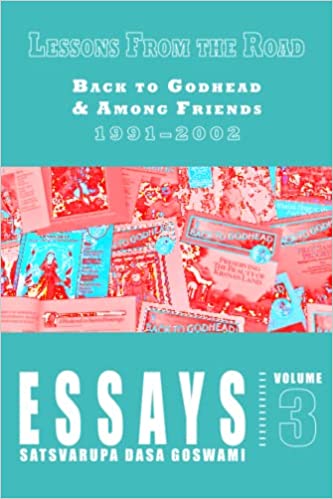
This collection of Satsvarupa dasa Goswami’s writings is comprised of essays that were originally published in Back to Godhead magazine between 1991 and 2002, picking up where Volume 2 leaves off. The volume is supplemented by essays about devotional service from issues of Satsvarupa dasa Goswami’s magazine, Among Friends, published in the 1990s.
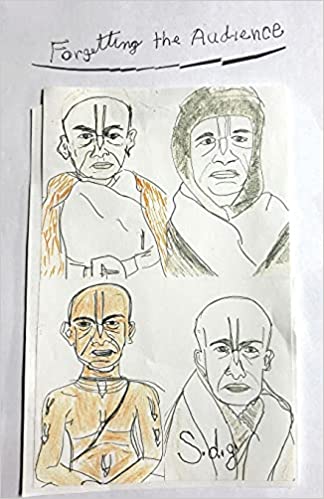
Writing Sessions at Castlegregory, Ireland, 1993Start slowly, start fastly, offer your obeisances to your spiritual master, His Divine Grace A.C. Bhaktivedanta Swami Prabhupada. You just drew his picture with your pencils. He appears carved out of wood…
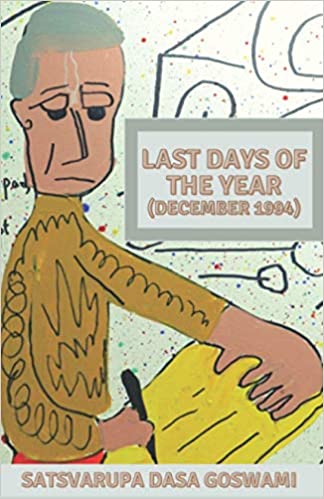 Last Days of the Year
Last Days of the YearI found I had hit a stride in my search for theme in writing, then began to feel the structure limiting me. After all, I had given myself precious time to write full-time; I wanted to enter the experience as fully as possible. For me, this means free-writing—writing sessions with no predetermined shape, theme, or topic…
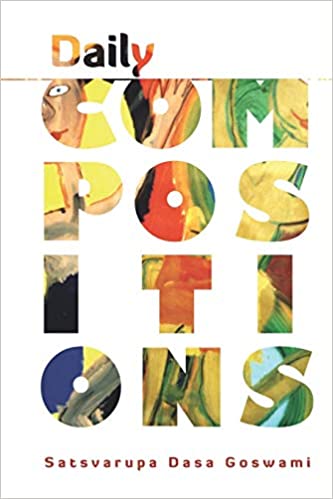 aily Compositions
aily CompositionsThis volume is comprised of three parts: prose meditations, free-writes, and poems each of which will be discussed in turn. As an introduction, a brief essay by the author, On Genre, has also been included to provide contextual coordinates for the writing which follows…
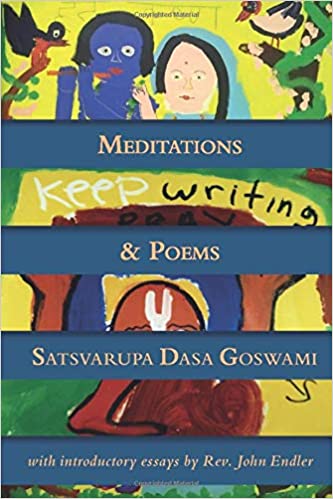 Meditations & Poems
Meditations & PoemsA comprehensive retrospective of poetic achievement and prose meditations, using a new trajectory described as “free-writing”. This volume will offer to readers an experience of the creativity versatility which is a hallmark of this author’s writing.
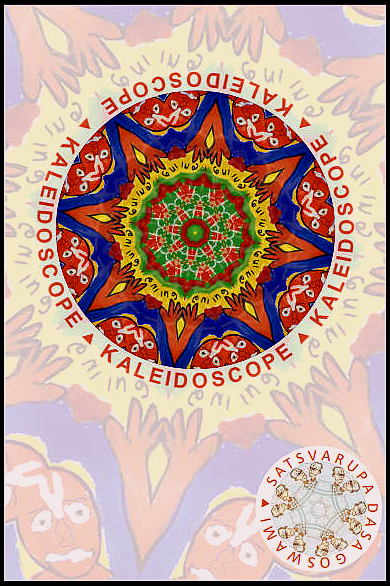 Kaleidoscope
KaleidoscopeStream of consciousness poetry that moves with the shifting shapes and colors characteristic of a kaleidoscope itself around the themes of authenticity. This is a book will transport you to the far reaches of the author’s heart and soul in daring ways and will move you to experience your own inner kaleidoscope.
Read more »
 A narrative poem. challenging and profound, about the journey of an itinerant monk who pursues new means of self-Seeking New Land
A narrative poem. challenging and profound, about the journey of an itinerant monk who pursues new means of self-Seeking New Landexpression.The reader is invited to discover his or her own spiritual pilgrimage within these pages as the author pushes every literary boundary to boldly create something wholly new and inspiring.